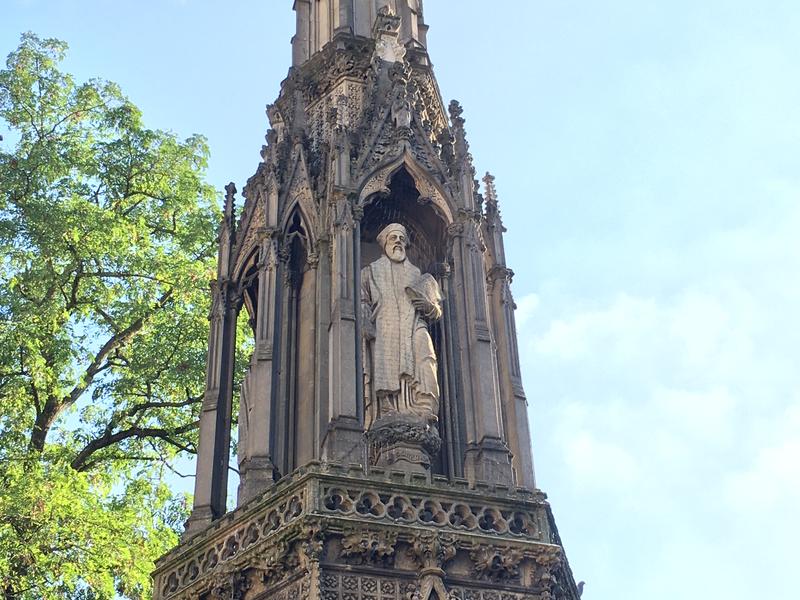Spotlight on Research: Oxford Reformed

In January of this year, the Museum of Oxford launched a new digital exhibition, entitled ‘Oxford Re-Formed’. Curated by members of both the English and History Faculties – Professors Susan Doran, Paulina Kewes, and William Whyte, and DPhil students Christopher Archibald and Anna Clark – this interdisciplinary project sought to take a fresh look at the legacies of the Reformation in Oxford. Through a range of images, texts, and artefacts, the exhibition narrates how religious change and conflict have been remembered and reimagined in Oxford from the sixteenth century to the present day.
When you think about Oxford and the Reformation, the first thing that might spring to mind is the Martyrs’ Memorial on St Giles. Completed in 1843, it commemorates the martyrdoms of Bishops Hugh Latimer and Nicholas Ridley in 1555, and Archbishop Thomas Cranmer in 1556, burnt at the stake for heresy. What might be less familiar is the bitter controversy it provoked when first installed.
The Memorial was embroiled in conflicts surrounding the Oxford Movement and the contested legacies of the Reformation. While some wished to preserve the memory of the early reformers against the likes of Newman and Pusey, others feared the divisiveness it might cause. Augustus Welby Pugin, architect of the Houses of Parliament and convert to Roman Catholicism, was so incensed by the plans that he wrote a scathing tract defaming the three martyrs’ characters in terms that would not be out of place in sixteenth-century polemic. Pugin had recently been appointed to design new buildings for Balliol College; as the Oxford Chronicle reported ‘Mr. Pugin wrote bitterly against the memorial, and he is now employed to set up restorations over against it at the very college whose walls reflected the martyrs’ fires.’ Perhaps unsurprisingly, Pugin lost his commission. Our project has sought to uncover the contested acts of remembering and reimagining that have made Oxford what it is today. The story of the Martyrs’ Memorial is just one piece in this puzzle.
Over the course of our research, the project rapidly expanded in scope. While we had set out to look for memories of sixteenth-century reform in modern Oxford, we soon realised that there was a different, much larger, more complex and overlapping story to be told. It is difficult to fix a point at which the Reformation ended and the process of remembering began. From the outset the Reformation involved contrasting ideas about the past and its meaning for the present and to a great extent these debates and conflicts never really ended but re-emerge in different ways and contexts across the centuries. The exhibition therefore looks at both the Protestant and Catholic Reformations and ranges from the Dissolution of the Monasteries to nineteenth-century political reform, via Civil Wars and the Enlightenment. Oxford’s community and built environment have changed repeatedly and dramatically as a result of religious upheaval.
The exhibition also shows how, since the nineteenth century, the legacies of the Reformations have become bound up with the histories of educational and political reform, of empire, and of the arrival of new religious communities to the city and to the university. In 1871, the Universities Tests Act allowed non-Anglican men (it would take at least another fifty years for women) to attend, and take degrees at, Oxford for the first time; new Colleges, buildings and communities soon emerged in the city. Mansfield, the first nonconformist College, was established at Oxford in 1886, but the windows in its chapel look right back to the seventeenth century, commemorating Puritans and early proponents of religious toleration. We have also traced how, in this period, missionary and colonial activity transformed Oxford’s cityscape. Memorials to empire can be found throughout Oxford – in collections amassed by colonialists and windows depicting missionaries for instance – and they are impossible to separate from the religious history of the city. Struggles over memorialisation have remained almost a constant in Oxford from the sixteenth to the twenty-first centuries.
Beyond the obvious memorials and statues, the exhibition considers a wide range of objects and artefacts as sites of remembering – paintings, old vestments, entire buildings, hats, weather vanes, objects broken and half repaired, and plans never completed. Many of these images and artefacts live behind the closed doors of colleges, in archives and private spaces. With the help of the Museum of Oxford, we wanted to share them and the stories they tell to a wider community. Hopefully the exhibition will encourage residents and visitors to see Oxford in a different way, noticing almost everywhere on view the traces of the long reformations – it has certainly made me more conscious of living in a peculiarly haunted city.
The exhibition can be accessed here: https://moxdigiexhibits.omeka.net/exhibits/show/oxford-re-formed



